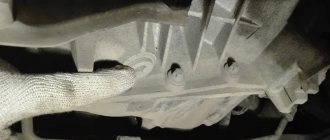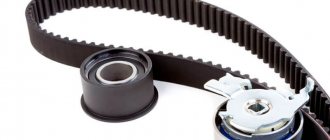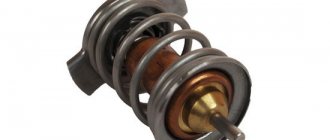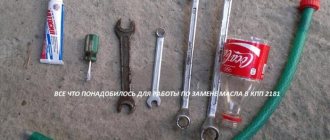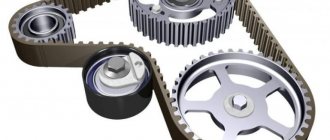A timing belt is a part whose service life is no more than 60,000 km (according to regulations!) , and it can be earlier if you handle the engine carelessly. The replacement frequency is affected by driving style and the serviceability of other engine components and assemblies.
In the video, replacing the timing belt on a 16-valve K4M Largus engine (similar to Sandero, Logan, Duster):
Replacing the timing belt on a 16-valve Lada Largus
Replacing the timing belt and pulley on a Lada Largus 16 valve requires some knowledge of the structure and operation of the engine, as well as tools. So, let's start describing the step-by-step instructions for replacing the timing belt:
- We remove the negative terminal from the battery.
- Remove the right engine mount. Before this, we dismantle the motor protection, and you need to place a special holding mechanism under the internal combustion engine.
Removed engine protection
Belt removed, no rollers
Put on new rollers and pump
This is how the marks are placed
Checking the alignment of marks on the block and timing belt
If you hear a whistle after the engine starts, then the roller is overtightened and needs to be loosened. The most difficult part of replacing the kit is the correct alignment of the VTM.
Need for replacement
The function of the timing belt is to communicate between the crankshafts and the camshafts. Thanks to it, the operation of the shafts is synchronized. Manufacturers of Lada Largus 16 valve recommend changing the timing belt along with the tension roller every 60,000 kilometers. But unscheduled replacements are possible due to the condition of the strap.
If you do not monitor its condition, the belt may break, which will have serious consequences for the Lada Largus with 16 valves. When a break occurs, the synchronization of the shafts disappears and the valves meet the pistons. As a result, valves bend, pistons deteriorate, and there is a high probability of damage to the surface of the cylinders.
This requires a major engine overhaul or replacement.
For this reason, it is advisable to inspect the components of the gas distribution mechanism after 10 thousand kilometers. The timing belt needs to be replaced if the following defects are found:
- cracks;
- surface wear, both internal and external;
- material delamination;
- wear and tear of teeth;
- frayed sides;
- traces of oil on both surfaces;
- low tension due to wear.
You need to inspect the belt, as well as the tension roller and water pump, replacing them if there are defects or play.
Belt selection
Many car owners, in order to save money, are wondering how to do the replacement themselves and which belt to choose?
Choosing a timing belt for the 16-valve Lada Largus engine is quite simple, since you can buy a timing belt repair kit, which includes the belt itself and 2 rollers. This will cost the owner much less than buying separately.
Let's look at the kit and separately the parts.
Original repair kit (two rollers and a timing belt)
A repair kit for the Lada Largus gas distribution mechanism costs an average of 3,000 rubles. It includes two rollers and the belt itself. The catalog number looks like this - 130C17529R .
Original timing belt
Now let's look at a belt made by Renault (cat. number - 8201069699 ). It is of excellent quality and lasts all 60 thousand kilometers.
Belt analogues
Also, there are analogues of the standard Lada Largus belt. Let's take a closer look:
| Manufacturer's name | vendor code | Average price in rubles in the Russian Federation |
| Dayco | 94997 | 1200 |
| Master-sport | 1126-SD-PCS-MS | 1200 |
| Contitech | CT 1179 | 1250 |
| Bosch | 1 987 949 686 | 1400 |
| LYNXauto | 132FL27 | 1500 |
| Gates | 5671 XS | 1650 |
| Febi | 19836 | 2000 |
All the manufacturers indicated in the table have proven themselves quite well and have high quality characteristics, and therefore are recommended for installation on the Lada Largus.
Original bypass roller
82 01 058 069 — deflection roller
Now, let’s look separately at the cost and article number of the Lada Largus timing tensioner pulley:
The original catalog number looks like this - 82 01 058 069 . The average cost of a Lada Largus timing pulley for 16 valves is 6,000 rubles.
Analogues of the video
There are a number of substitutes that can be installed instead of the original part:
| Manufacturer's name | vendor code | Average price in rubles in the Russian Federation |
| Dello | 30770001070150 | 700 |
| Pilenga | PT-P 7150 | 800 |
| Optimal | 0-N262 | 1500 |
| Ruville | 55640 | 1500 |
| Ina | 532 0221 10 | 1500 |
| SNR | GE355.38 | 1800 |
| Gates | T41237 | 2200 |
As can be seen from the table, the cost of analogues of the Lada Largus 16 valve timing pulley is more than half that of the original. But, at the same time, they are in no way inferior in quality.
Timing belt tensioner roller
Timing belt tensioner 8200061345
8200061345 — original number of the timing belt tensioner roller
Reasons for replacement
The main reasons for replacing the timing belt:
- Wear . The most frequent and inexorable factor. The process of using a part wears it out and over time the spare part has to be replaced.
Porepins can develop into a torn belt and engine “capital”
Engine capital
The timing belt is broken, the valves are bent (K4M Largus engine)
Filters, belts, consumables for Lada Vesta maintenance
Products from the Dustershop77 range on the topic of the article:
| Name | Manufacturer | Price | Availability | Add to cart |
| DC466-32149 | Oil drain plug gasket (engine 1.6, 2.0, diesel) ASAM 32149 analogue 110265505R | Analogue | 100 / 80 rub. Discount: 50 rub. | 8 |
| DC921-7700500168 | Spark plug two-pin (engine 1.6, 2.0) Renault 7700500168 / 7700103533 / 224013682R / 7700115827 | Original | 400 / 350 rub. Discount: 290 rub. | 4 |
| DC366-224011561r | Spark plug for H4M/HR16DE 1.6 114 HP engine. gasoline 224011561r original | Original | 1200 / 700 rub. Discount: 500 rub. | 8 |
| DC369-V144-165460509R | Air filter for engine H4M/HR16DE 1.6 114 hp. gasoline 165460509R original | Original | 1300 / 1100 rub. Discount: 800 rub. | 8 |
| DC365-152085758r | Oil filter for engine H4M/HR16DE 1.6 114 hp. gasoline original | Original | 1000 / 700 rub. Discount: 600 rub. | 1 |
| DC393 | Drive belt 1.6 H4M/HR16DE (WITH COND.) (DAYCO analogue 117203168R) | Analogue | 1500 / 1100 rub. Discount: 900 rub. | 2 |
| DC417-6PK1200 | Alternator belt 1.6 petrol H4M/HR16DE without air conditioning. DAYCO 6PK1200 (117208408R) | Analogue | 9000 / 600 rub. Discount: 500 rub. | 1 |
| DC1486-272773016R | Cabin filter Kaptur / Arcana 272773016R / 272773277R original | Original | 1500 / 1100 rub. Discount: 800 rub. | 6 |
| V101-NF6433C | Cabin filter Lada Vesta / X Rey Nevsky Filter NF6433C (carbon) | Analogue | 300 / 250 rub. Discount: 250 rub. | 3 |
| V155-21080101106200 | Original oil drain plug gasket (VAZ-21129/21179) | Original | 20 / 15 rub. Discount: 10 rub. | >10 |
| V151-911736 | Air filter TSN (VAZ-21129/21179) | Analogue | 350 / 250 rub. Discount: 200 rub. | 2 |
| V156-21120101106100 | Original oil drain plug (VAZ-21129/21179) | Original | 200 / 100 rub. Discount: 50 rub. | >10 |
| DC1605-EA711 | Air filter for engine H4M/HR16DE 1.6 114 hp. gasoline analogue 165460509R | Analogue | 800 / 600 rub. Discount: 400 rub. | 4 |
| V147-21110370701086 | Spark plugs (4 pieces included) original A17DVRM (VAZ-21129/21179) | Original | 600 / 400 rub. Discount: 400 rub. | 4 |
| V153-FO014 | Oil filter FORTECH (VAZ-21129/21179) | Analogue | 350 / 250 rub. Discount: 250 rub. | 2 |
| DC1557-8450033130 | Air filter original 8450033130 (Vesta new model) | Analogue | 1200 / 1000 rub. Discount: 800 rub. | 4 |
| V142-8450006328 | Auxiliary drive belt (generator) VAZ-21129/21179 | Original | 1500 / 1300 rub. Discount: 1300 rub. | 1 |
| V143-21080101200582 | Oil filter Lada Vesta original 21080101200582 (VAZ-21129/21179) | Original | 350 / 250 rub. Discount: 250 rub. | 1 |
| V145-8450006996 | Generator belt roller assembly original 8450006996 (VAZ-21129/21179) | Original | 2200 / 1900 rub. Discount: 1900 rub. | 1 |
| V146-272773151R | Cabin filter original 272773151R | Original | 1100 / 800 rub. Discount: 800 rub. | 1 |
| V148-21126100604086 | Original timing belt kit (VAZ-21129/21179) | Original | 4300 / 4200 rub. Discount: 4200 rub. | 1 |
| V150-K20TT | Spark plug DENSO 1pc. (VAZ-21129/21179) | Analogue | 250 / 200 rub. Discount: 200 rub. | 4 |
| V152-97888 | Cabin filter TSN (VAZ-21129/21179) | Analogue | 350 / 250 rub. Discount: 250 rub. | 1 |
| V153-CT1137K1 | Timing belt kit CONTITECH (VAZ-21129/21179) | Analogue | 3400 / 3100 rub. Discount: 3100 rub. | 1 |
conclusions
Replacing the timing belt and pulley on a Lada Largus is a rather complicated process, as it requires some knowledge and skills. But, if everything works out, then you can save a good amount of money. The choice of belt and roller is up to the owner. As a rule, cheap and expensive parts cost the same, so there is not much difference when choosing. But it is not recommended to buy a very cheap belt, it can quickly wear out.
Timing timing parts must be changed in accordance with the regulations established by the manufacturer. Their condition must be constantly monitored to prevent damage. One of the main timing parts is the transmission. Without proper attention, it may well break off. Here we will give instructions for replacing the timing belt drive on a sixteen valve Lada Largus. The whole process is described in sufficient detail, therefore, after studying these instructions, anyone can cope with repairs of such complexity.
When to change the timing belt on Largus?
A belt drive connects the shafts of the motor system. The manufacturer promises that the belt will last 60,000 km. It is quite possible that this is actually the case, but the need for an unscheduled belt replacement also cannot be ruled out. And the belt may well wear out before its due date, which may be due to a number of reasons. The main one is an aggressive driving style, which, unfortunately, is practiced by some drivers. Increased loads also wear out the belt ahead of time. One cannot help but mention the incorrect installation of the belt. This may also well affect its early wear. The belt has arrows indicating the direction of movement. It is in this direction that it needs to be installed, otherwise the teeth located on the inside will wear out very quickly. But not all belts have such indicators.
Replacement steps
It is better to carry out the entire procedure on an overpass. Before carrying out work, the vehicle must be de-energized by disconnecting the terminal from the battery. The vehicle must be securely secured.
1. Dismantle the drive of additional units. 2. After this, remove the pulley. To do this you will have to unscrew the mounting bolt. 3. Remove the engine mount located on the right. 4. We remove the timing covers and the entire mechanism appears before our eyes.
5. Scroll the crankshaft until the mark located on its pulley aligns with the vertical axis of the pulley. The alignment does not have to be complete, the mark should be 1 tooth away from the center of the pulley. After this, turn the crankshaft to the right until it stops. 6. Remove the plugs from the holes on the cylinder head, having previously dismantled the air collector. This is done so that you can check the alignment of the marks on the camshafts. 7. Turn the crankshaft until the grooves on it are horizontal. 8. Fix the camshafts using a mandrel. 9. Loosen the tensioner fasteners and begin to turn the tension roller to the left to loosen the tension of the belt drive. 10. After this you can remove the belt. 11. The tension roller should be carefully inspected and, if necessary, replaced. 12. When installing the tensioner, make sure that the groove located on the motor aligns with the same mark on the roller.
13. We install and tension the new belt drive. The tension should be normal. 14. We get rid of all the fasteners and install new plugs on the cylinder head. 15. Other parts are installed in reverse order.
Separately, I would like to say about the tension of the belt drive. If it is not sufficient, the belt may come off. A loose belt will slip. Friction will cause early wear of the rubber. And if the belt is overtightened, bearings and other mechanisms may suffer.
To determine the correct gear tension, you need to pay attention to the tension roller. It has movable and fixed indicators. If the movable one is located slightly to the left of the stationary one, the belt needs to be tightened, if it is to the right, loosen it. To adjust the tension, you need to loosen the tension roller and turn it clockwise until the indicators are completely aligned. Then the crankshaft will have to be turned 2 turns to the right. After the adjustment process is completed, it must be tightened again.
How to make the replacement yourself?
Having experience in repair work on a Lada Largus with a 16-valve engine, having studied the replacement instructions and watched the video, you can completely cope with the replacement yourself. You can invite an assistant, preferably with experience in auto repair.
Required Tools
To successfully carry out work on the Lada Largus 16 valve, you should be properly prepared. You need to prepare the following tools:
- set of keys and sockets;
- extension;
- screwdriver;
- crankshaft mandrel;
- camshaft mandrel.
You should buy new products only from trusted manufacturers and preferably originals, otherwise they may not last as long as they should. By saving on cost, you can end up with expensive repairs in the event of a break or replacement of components ahead of schedule.
Stages of work
It is most convenient to carry out the replacement procedure on a lift, overpass or inspection pit. The sequence of work on the Lad Largus 16 valve consists of the following steps:
- First, turn off the power to the car by disconnecting the negative terminal from the battery.
Engine compartment of Lada Largus 16 valves - Next, you need to remove the inlet pipe and the accessory drive belt.
- After unscrewing the bolt securing the auxiliary mechanism pulley, you need to dismantle the pulley.
- Next you need to remove the right engine mount.
- After unscrewing the mounting bolts, you need to remove the upper and lower timing cover.
Gas distribution mechanism Lada Largus 16 cl - After tightening the crankshaft pulley mounting bolt, turn the crankshaft until the mark on the camshaft pulley is at a distance of one tooth from the vertical axis of the pulley, while the mark on the crankshaft pulley should also be at a distance of one tooth from the pulley axis.
- Next, install the mandrel to fix the crankshaft and turn it clockwise until it stops.
- To check the camshaft marks, remove the plugs on the holes in the left end of the cylinder head. To do this, first dismantle the air collector. Then, having pierced the plugs in the center with a screwdriver, we take them out, opening the holes. In the video you can see how to do this.
- The crankshaft should be rotated until the grooves on the camshafts are in a horizontal position. To fix the camshafts, a special mandrel is installed.
- Then you need to loosen the tensioner mounting bolt. By turning the tension roller counterclockwise, you need to loosen the tension on the timing belt and remove it from the tensioner.
- Then the belt is removed from the pump pulley, crankshaft and camshafts.
- After unscrewing the tension roller mounting bolt, remove it and replace it with a new one.
- When installing a new tensioner, make sure that the groove on the engine aligns with the protrusion on the pulley.
- We tighten the new timing belt first on the crankshaft, then on the water pump and camshafts. In this case, you should focus on the arrows printed on the belt; they should be directed in the direction of travel.
- After replacement, we adjust the tension of the timing belt.
- Next, remove the clamps from the crankshaft and camshafts. We install new plugs into the holes on the cylinder head.
- Further assembly is carried out in reverse order.
Tension check
Belt tension is of great importance for the normal operation of the timing belt. If the belt is loose, it can slip and cause valve timing problems. In addition, slippage can cause increased friction and the material will heat up, which can cause the strap to break. High tension accelerates wear on the crankshaft bearings and auxiliary mechanisms.
Checking the belt tension is possible using indicators on the tension roller. Normal tension implies complete coincidence of the movable pointer with the stationary pointer of the tensioner. If the moving pointer moves slightly counterclockwise, the strap should be tightened.
In this case, you need to loosen the tensioner mounting bolt and turn the tension roller clockwise until the indicators align. Having fixed the tensioner in this position, it is necessary to tighten the fastening bolt. Then use the auxiliary pulley mounting bolt to turn the crankshaft two turns. Now you need to check the tension again. Adjustments should be made until the desired tension level is achieved.
Video
The Lada Largus model is loved by many owners of this car. The designers made the car quite roomy, which allows it to be defined as a “family” car, and the budget price of the car was liked by a large number of commercial organizations that use it as a traveling vehicle.
Therefore, it will be useful for drivers to know how to replace the timing belt on a Lada Largus. This is important, because when the belt fails, the pistons meet the valves and damage the valve mechanism.
16 valve engines
The basis for this station wagon was the Dacia Logan MCV from Renault. Initially, two power units with a working volume of 1600 cm 3 K7M, K4M of this company were installed in Largus. In 2020, the K7M was replaced by the VAZ 11189 with eight valves in the cylinder head, and in 2020 the VAZ 21129 appeared. This engine already has 16 valves in the cylinder head; a little later it began to be installed on Vesta, Lada XRAY.
After mastering the production of this power unit, the automobile plant abandoned the use of engines produced by the Renault-Nissan concern. The car's transmission remained from Renault, but with significant modifications for operating conditions in the regions of Russia and other CIS countries.
The power unit of this modification is available only on a seven-seater station wagon or on cars with the “Lux” package. The engine displacement is 1600 cm3, 16 valves are installed in the cylinder head. Its power is 102 horsepower with a compression ratio of 9.5. Average fuel consumption is within 7.9 liters per hundred kilometers. Experts and car owners note that the noise of the running engine is reduced, vibration in all modes of its operation is completely eliminated.
As a disadvantage, insufficiently high dynamic performance of the engine and the occurrence of misfires when operating on fuel of dubious quality are noted. The complex design of the engine affects the conditions of its assembly, and this slightly increases the cost of the engine, and therefore the cost of servicing this unit increases compared to engines with 8 valves in the cylinder head. Manufacturers promise a resource for the engine of at least 450 thousand kilometers, or even more, if it is maintained correctly and in a timely manner.
VAZ-21129
This engine also has a displacement of 1600 cm 3, 16 valves in the timing drive. Its power was increased slightly, it became equal to 106 hp. With. Structurally, it is not too different from most serial VAZ engines. Cast iron cylinder block, their in-line arrangement, toothed belt in the timing mechanism drive. Hydraulic compensators are not installed. It has become more reliable and less critical of the composition of the fuel used.
The gearbox is mechanical, it remained from the Frenchman, but with significant modifications to adapt it to operating conditions in the regions of the Russian Federation. In the gearbox, the gear ratios for third, fourth, and fifth gears have been changed. This allowed the car to move at lower engine speeds, acoustic noise decreased, and gasoline consumption decreased. Average fuel consumption did not go beyond 7.9 liters per hundred kilometers.
Replacement procedure for K4M
It is recommended to carry out the replacement on a lift or in the presence of an inspection ditch, since many elements have to be removed from the bottom of the machine. In addition to a set of wrenches and sockets, you will need a set of special Torx keys. And you also need a car jack, wheel chocks, and reliable stands for the car body. You will need a stand for the engine crankcase, since you will have to remove the power unit support.
If you have no experience with replacement, we recommend contacting a car service center.
You will also need to purchase a crankshaft clamp for this engine (estimated cost is 400 rubles)
Replacing the timing belt on a Lada Largus will be done approximately as follows:
- The car is installed at the work site, the handbrake is applied, and wheel chocks are installed.
- On the right front wheel, remove the wheel bolts, then lift the right side of the car and remove the wheel.
- Access to the engine is hampered by a protective shield located on the right wheel well mudguard, which must be removed.
- The generator set drive belt can now be removed. The drive tension is carried out by an automatic tensioning device. To loosen the belt tension, you need to place a 13mm spanner on the head of the tension roller mounting bolt and turn it upwards to the left. After this, the belt is easily removed from the pulleys.
- During operation, you will have to lock the engine crankshaft, so unscrew the crankshaft plug mounting bolt using an internal Torx E14 wrench.
- Next, the power unit is lowered onto a support, which is installed on the ribs of the engine oil pan.
- The further process is hampered by the right engine mount, which must be removed. To do this, disconnect the two hoses on top of the support, then turn out the six bolts with a “16” head. Next, remove the engine mount from the engine compartment.
- In the future, you will have to have access to the plugs on the camshafts on the right side of the engine; access to them is limited by the air receiver. It is easy to remove, just remove the rubber band that secures it, pull back the throttle cable, and the receiver is removed.
- The camshafts are closed with plugs that are removed. Use a powerful screwdriver to pierce the plug in the center and pull it out of its place. Upon completion of work, new plugs are installed in place.
Is it necessary to change the pump when replacing the timing belt?
Content
Lad Largus 16 valves. Replacement time: instructions. When do I need to replace my timing belt on Lade-Largus?
The time to Largus (16 valves) according to the maintenance table must be changed. The condition of the belt drive depends on the precise distribution of gas in the engine. Moves from the crankshaft using a helical belt to the fluid pump and camshafts.
During repairs, you should pay attention to all related items. If the fluid pump is faulty or the camshaft pulleys are severely damaged, these items will need to be replaced. Buy spare parts only from trusted manufacturers and reputable sellers.
Belt replacement intervals
The timing belt was replaced at 60,000 km Lada-Largus (16 valves). The principle of operation is that for every revolution of the crankshaft, half a revolution of the distribution box is required. Therefore, the replacement procedure should be carried out with particular seriousness, especially for engines with 16 valves. After all, you can always break the belt and damage the valves, pistons, and liners.
But there are times when you need an unplanned drive replacement. This usually happens when the belt drive wears out a lot or when it breaks. Of course, belt breaks are unlikely to damage the valves and pistons since they are of a "robust" design. But it is necessary to monitor its condition so that a failure does not occur at the most inopportune moment. It is advisable to have at least a used timing belt. This will allow you to repair your car much faster, even in the field.
Diagnostic mechanism
But before you change the timing belt on a Lade-Largus (16 valves), you need to make sure that it has already reached its end of life or that it is damaged. It is advisable to check every 10 thousand kilometers.
READ Where are the fuses located on a Toyota Hiace
No special tools are required for repair, just a visual inspection:
- Please note that there is a crack on the surface of the belt. If present, they may enlarge during operation, causing belt damage.
- If there is excessive wear on the outer or inner surfaces, the belt must be replaced.
- Pay attention to the presence of beams.
- Assess the condition of your teeth.
- There should be no signs of wear on the side surfaces.
- The voltage should be normal. Check it out for video pointers.
- If oil stains are present on the elements of the gas distribution mechanism
, this indicates a malfunction.
What else to do when replacement time?
If you decide to replace the timing belt on a 16-valve engine, it is recommended that you check the condition of all system components to ensure they are in good working order. If there are unusual sounds when the engine is running, this is obviously a sign that you need to replace the drive belt and rollers. These components are replaced anyway, but the pump and pulleys last a little longer. In particular, pulleys can serve at least 120 thousand km, which is quite a long mileage. But usually they “go away” much longer.
If it is necessary to hand over the PUMP to replace the Chevrolet Lacetti timing belt. # Alexey Zakharov. Car repair
Do I need to change POMPU when replacing
Chevrolet Lackett
timing belt , replacing the pump at
60,000 km. It's me.
When replacing the timing belt, replace the cooling system pumps
Service station website: many customers resist when we recommend changing the pump
system.
Tools for repair
To replace the camshaft drive 16 you will need the following tools:
- Set of wrenches, sockets, ratchets and extensions.
- Several screwdrivers.
- Special mandrel for crankshaft and camshaft.
- Special button for belt tension.
READ Replacement Head Gasket BMW M52
Buy a repair kit in advance. It includes a belt and rollers. If the shaft and pump pulley are badly worn, these items will need to be purchased.
When is the fluid pump due?
When replacing a seat belt on a Lada Largus, be sure to take into account the fact that the service life of the liquid pump does not exceed 100,000 km. Similar service life and antifreeze of any brand. For this start, all the additives it contains evaporate, reducing the efficiency of the entire engine cooling system.
Therefore, if the fluid pump has reached the end of its service life, it is recommended to add fresh antifreeze and install a new pump. And if the car is operated with care, then after several years of driving 60 thousand km, it is necessary to change the elements of the gas distribution system, pump and antifreeze at least once every two years. To replace time with Largus (16 valves), you need to be very careful, since a complex system and the slightest desynchronization of the shafts will lead to a sad result.
Preparatory work
If you forgot, replacing the timing belt with a Largus (16 valves) will improve the repair. If you do not want to replace it yourself, contact your service center. To make repairs on your own, you will need to do the following preparatory work:
- Disconnect the negative cable from the battery. Thus, you will fully provide your car with electricity.
- Disconnect the intake pipe, then remove the alternator drive belt and other accessories.
- On the right side of the engine you will be concerned about the support, so it must be removed.
- The protective cover consists of a lower and an upper half. They need to be removed by unscrewing the mounting bolts.
That's all, the preparatory work is completed. The time to replace the Largus (16 valves) can begin.
READ Replacement Rear Stabilizer Struts Passat B6
How to remove the belt drive?
First, tighten the crankshaft bolt completely. Then the pulley rotates until the marks match. Please note that they should not be more than one tooth from the vertical. Then perform the following manipulations:
- Install the crankshaft mounting mechanism.
- Then turn it counterclockwise until it stops.
- Make sure all camshaft marks are correct. To do this, remove the plugs located in the inspection windows at the end of the cylinder head. Before doing this, be sure to remove the air filter housing. The plugs are removed using a simple screwdriver or thin silk.
- The crankshaft must then be rotated so that the grooves are secured horizontally to the camshafts. Use mandrels for fastening.
- Loosen the tension nut. Then turn the roller counterclockwise.
The drive belt will then be unlocked and can be easily removed. The Largus replacement is about the same as most modern cars.
How to install a new belt?
But this time the replacement for Largus (16 valves) is not completed, new parts need to be installed:
- Be sure to replace the rollers, just unscrew the bolts that secure them. New parts must be delivered to their place.
- Please note that there is a small protrusion on the idler pulley housing. Should be combined with the groove on the car cylinder block.
- Carefully install the new drive belt, first sliding it onto the crankshaft pulley, then onto the pump. Last but not least, it must be mounted on the camshafts. Pay attention to the arrows that are painted on the outside of the drive belt.
- Adjust the tension using the special switch.
Then you can safely remove the locks mounted on the crankshaft and camshaft.
The belt is replaced at this time the timing mechanism is completed. Be sure to replace the old ones with new ones in the cylinder head cover. Do not forget about them, otherwise oil leakage will occur.


